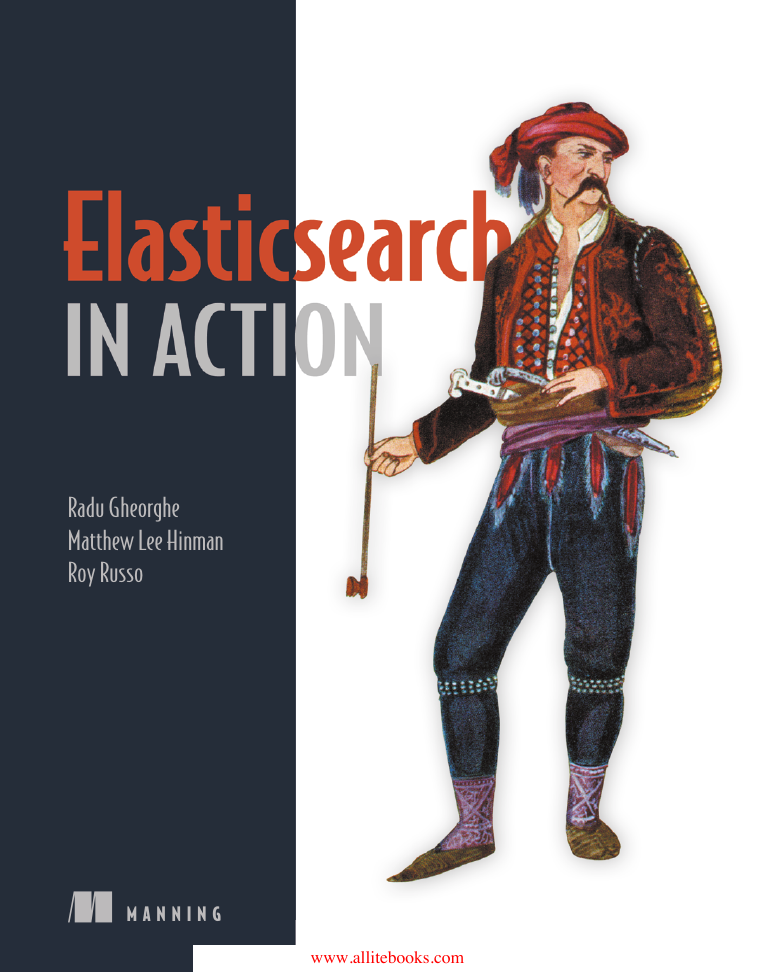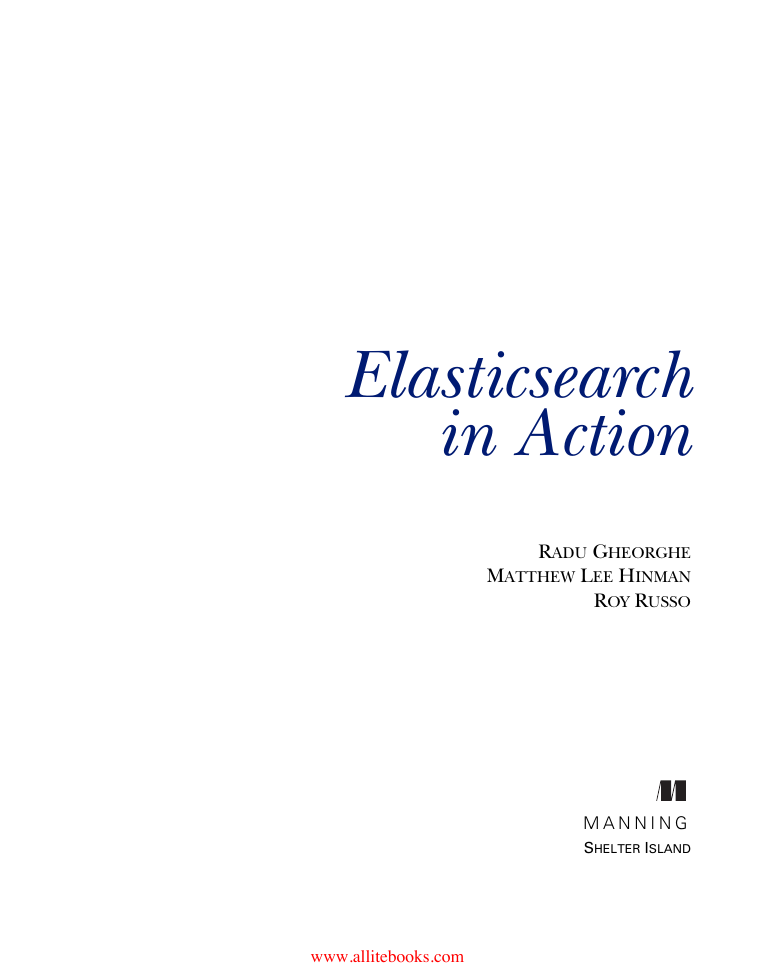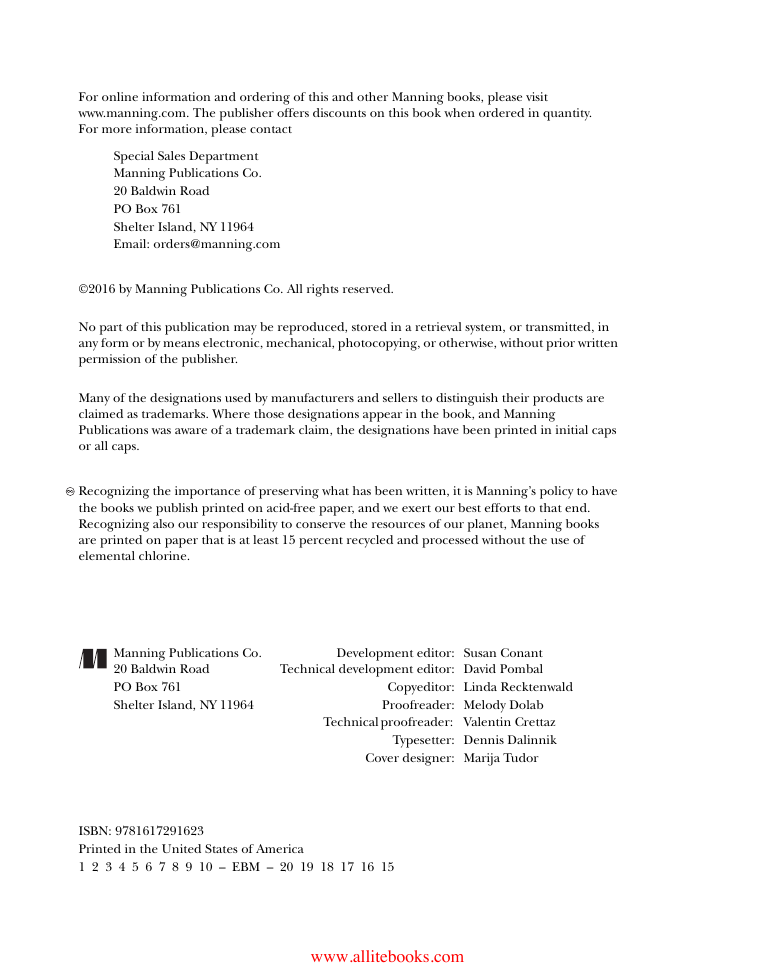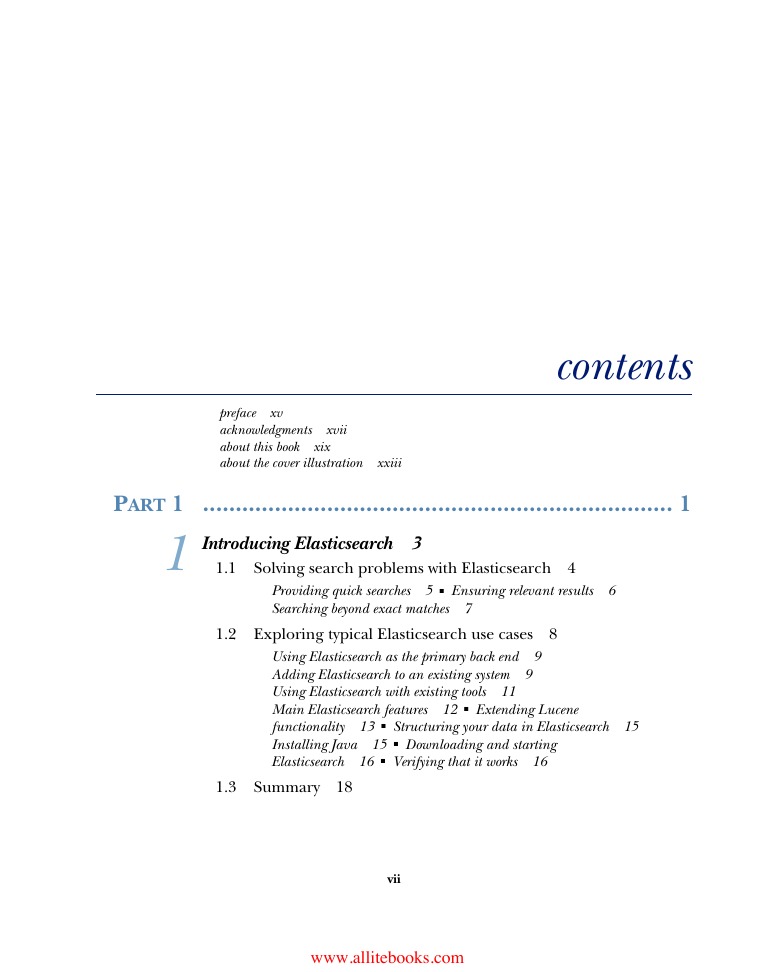Front cover
brief contents
contents
preface
acknowledgments
about this book
Roadmap
Code conventions and downloads
Author Online
about the cover illustration
Part 1
1 Introducing Elasticsearch
1.1 Solving search problems with Elasticsearch
1.1.1 Providing quick searches
1.1.2 Ensuring relevant results
1.1.3 Searching beyond exact matches
1.2 Exploring typical Elasticsearch use cases
1.2.1 Using Elasticsearch as the primary back end
1.2.2 Adding Elasticsearch to an existing system
1.2.3 Using Elasticsearch with existing tools
1.2.4 Main Elasticsearch features
1.2.5 Extending Lucene functionality
1.2.6 Structuring your data in Elasticsearch
1.2.7 Installing Java
1.2.8 Downloading and starting Elasticsearch
1.2.9 Verifying that it works
1.3 Summary
2 Diving into the functionality
2.1 Understanding the logical layout: documents, types, and indices
2.1.1 Documents
2.1.2 Types
2.1.3 Indices
2.2 Understanding the physical layout: nodes and shards
2.2.1 Creating a cluster of one or more nodes
2.2.2 Understanding primary and replica shards
2.2.3 Distributing shards in a cluster
2.2.4 Distributed indexing and searching
2.3 Indexing new data
2.3.1 Indexing a document with cURL
2.3.2 Creating an index and mapping type
2.3.3 Indexing documents from the code samples
2.4 Searching for and retrieving data
2.4.1 Where to search
2.4.2 Contents of the reply
2.4.3 How to search
2.4.4 Getting documents by ID
2.5 Configuring Elasticsearch
2.5.1 Specifying a cluster name in elasticsearch.yml
2.5.2 Specifying verbose logging via logging.yml
2.5.3 Adjusting JVM settings
2.6 Adding nodes to the cluster
2.6.1 Starting a second node
2.6.2 Adding additional nodes
2.7 Summary
3 Indexing, updating, and deleting data
3.1 Using mappings to define kinds of documents
3.1.1 Retrieving and defining mappings
3.1.2 Extending an existing mapping
3.2 Core types for defining your own fields in documents
3.2.1 String
3.2.2 Numeric
3.2.3 Date
3.2.4 Boolean
3.3 Arrays and multi-fields
3.3.1 Arrays
3.3.2 Multi-fields
3.4 Using predefined fields
3.4.1 Controlling how to store and search your documents
3.4.2 Identifying your documents
3.5 Updating existing documents
3.5.1 Using the update API
3.5.2 Implementing concurrency control through versioning
3.6 Deleting data
3.6.1 Deleting documents
3.6.2 Deleting indices
3.6.3 Closing indices
3.6.4 Re-indexing sample documents
3.7 Summary
4 Searching your data
4.1 Structure of a search request
4.1.1 Specifying a search scope
4.1.2 Basic components of a search request
4.1.3 Request body–based search request
4.1.4 Understanding the structure of a response
4.2 Introducing the query and filter DSL
4.2.1 Match query and term filter
4.2.2 Most used basic queries and filters
4.2.3 Match query and term filter
4.2.4 Phrase_prefix query
4.3 Combining queries or compound queries
4.3.1 bool query
4.3.2 bool filter
4.4 Beyond match and filter queries
4.4.1 Range query and filter
4.4.2 Prefix query and filter
4.4.3 Wildcard query
4.5 Querying for field existence with filters
4.5.1 Exists filter
4.5.2 Missing filter
4.5.3 Transforming any query into a filter
4.6 Choosing the best query for the job
4.7 Summary
5 Analyzing your data
5.1 What is analysis?
5.1.1 Character filtering
5.1.2 Breaking into tokens
5.1.3 Token filtering
5.1.4 Token indexing
5.2 Using analyzers for your documents
5.2.1 Adding analyzers when an index is created
5.2.2 Adding analyzers to the Elasticsearch configuration
5.2.3 Specifying the analyzer for a field in the mapping
5.3 Analyzing text with the analyze API
5.3.1 Selecting an analyzer
5.3.2 Combining parts to create an impromptu analyzer
5.3.3 Analyzing based on a field’s mapping
5.3.4 Learning about indexed terms using the terms vectors API
5.4 Analyzers, tokenizers, and token filters, oh my!
5.4.1 Built-in analyzers
5.4.2 Tokenization
5.4.3 Token filters
5.5 Ngrams, edge ngrams, and shingles
5.5.1 1-grams
5.5.2 Bigrams
5.5.3 Trigrams
5.5.4 Setting min_gram and max_gram
5.5.5 Edge ngrams
5.5.6 Ngram settings
5.5.7 Shingles
5.6 Stemming
5.6.1 Algorithmic stemming
5.6.2 Stemming with dictionaries
5.6.3 Overriding the stemming from a token filter
5.7 Summary
6 Searching with relevancy
6.1 How scoring works in Elasticsearch
6.1.1 How scoring documents works
6.1.2 Term frequency
6.1.3 Inverse document frequency
6.1.4 Lucene’s scoring formula
6.2 Other scoring methods
6.2.1 Okapi BM25
6.3 Boosting
6.3.1 Boosting at index time
6.3.2 Boosting at query time
6.3.3 Queries spanning multiple fields
6.4 Understanding how a document was scored with explain
6.4.1 Explaining why a document did not match
6.5 Reducing scoring impact with query rescoring
6.6 Custom scoring with function_score
6.6.1 weight
6.6.2 Combining scores
6.6.3 field_value_factor
6.6.4 Script
6.6.5 random
6.6.6 Decay functions
6.6.7 Configuration options
6.7 Tying it back together
6.8 Sorting with scripts
6.9 Field data detour
6.9.1 The field data cache
6.9.2 What field data is used for
6.9.3 Managing field data
6.10 Summary
7 Exploring your data with aggregations
7.1 Understanding the anatomy of an aggregation
7.1.1 Structure of an aggregation request
7.1.2 Aggregations run on query results
7.1.3 Filters and aggregations
7.2 Metrics aggregations
7.2.1 Statistics
7.2.2 Advanced statistics
7.2.3 Approximate statistics
7.3 Multi-bucket aggregations
7.3.1 Terms aggregations
7.3.2 Range aggregations
7.3.3 Histogram aggregations
7.4 Nesting aggregations
7.4.1 Nesting multi-bucket aggregations
7.4.2 Nesting aggregations to get result grouping
7.4.3 Using single-bucket aggregations
7.5 Summary
8 Relations among documents
8.1 Overview of options for defining relationships among documents
8.1.1 Object type
8.1.2 Nested type
8.1.3 Parent-child relationships
8.1.4 Denormalizing
8.2 Having objects as field values
8.2.1 Mapping and indexing objects
8.2.2 Searching in objects
8.3 Nested type: connecting nested documents
8.3.1 Mapping and indexing nested documents
8.3.2 Searches and aggregations on nested documents
8.4 Parent-child relationships: connecting separate documents
8.4.1 Indexing, updating, and deleting child documents
8.4.2 Searching in parent and child documents
8.5 Denormalizing: using redundant data connections
8.5.1 Use cases for denormalizing
8.5.2 Indexing, updating, and deleting denormalized data
8.5.3 Querying denormalized data
8.6 Application-side joins
8.7 Summary
Part 2
9 Scaling out
9.1 Adding nodes to your Elasticsearch cluster
9.1.1 Adding nodes to your cluster
9.2 Discovering other Elasticsearch nodes
9.2.1 Multicast discovery
9.2.2 Unicast discovery
9.2.3 Electing a master node and detecting faults
9.2.4 Fault detection
9.3 Removing nodes from a cluster
9.3.1 Decommissioning nodes
9.4 Upgrading Elasticsearch nodes
9.4.1 Performing a rolling restart
9.4.2 Minimizing recovery time for a restart
9.5 Using the _cat API
9.6 Scaling strategies
9.6.1 Over-sharding
9.6.2 Splitting data into indices and shards
9.6.3 Maximizing throughput
9.7 Aliases
9.7.1 What is an alias, really?
9.7.2 Alias creation
9.8 Routing
9.8.1 Why use routing?
9.8.2 Routing strategies
9.8.3 Using the _search_shards API to determine where a search is performed
9.8.4 Configuring routing
9.8.5 Combining routing with aliases
9.9 Summary
10 Improving performance
10.1 Grouping requests
10.1.1 Bulk indexing, updating, and deleting
10.1.2 Multisearch and multiget APIs
10.2 Optimizing the handling of Lucene segments
10.2.1 Refresh and flush thresholds
10.2.2 Merges and merge policies
10.2.3 Store and store throttling
10.3 Making the best use of caches
10.3.1 Filters and filter caches
10.3.2 Shard query cache
10.3.3 JVM heap and OS caches
10.3.4 Keeping caches up with warmers
10.4 Other performance tradeoffs
10.4.1 Big indices or expensive searches
10.4.2 Tuning scripts or not using them at all
10.4.3 Trading network trips for less data and better distributed scoring
10.4.4 Trading memory for better deep paging
10.5 Summary
11 Administering your cluster
11.1 Improving defaults
11.1.1 Index templates
11.1.2 Default mappings
11.2 Allocation awareness
11.2.1 Shard-based allocation
11.2.2 Forced allocation awareness
11.3 Monitoring for bottlenecks
11.3.1 Checking cluster health
11.3.2 CPU: slow logs, hot threads, and thread pools
11.3.3 Memory: heap size, field, and filter caches
11.3.4 OS caches
11.3.5 Store throttling
11.4 Backing up your data
11.4.1 Snapshot API
11.4.2 Backing up data to a shared file system
11.4.3 Restoring from backups
11.4.4 Using repository plugins
11.5 Summary
Appendix A—Working with geospatial data
A.1 Points and distances between them
A.2 Adding distance to your sort criteria
A.2.1 Sorting by distance and other criteria at the same time
A.3 Filter and aggregate based on distance
A.4 Does a point belong to a shape?
A.4.1 Bounding boxes
A.4.2 Geohashes
A.5 Shape intersections
A.5.1 Indexing shapes
A.5.2 Filtering overlapping shapes
Appendix B—Plugins
B.1 Working with plugins
B.2 Installing plugins
B.3 Accessing plugins
B.4 Telling Elasticsearch to require certain plugins
B.5 Removing or updating plugins
Appendix C—Highlighting
C.1 Highlighting basics
C.1.1 What should be passed on to the user
C.1.2 Too many fields contain highlighted terms
C.2 Highlighting options
C.2.1 Size, order, and number of fragments
C.2.2 Highlighting tags and fragment encoding
C.2.3 Highlight query
C.3 Highlighter implementations
C.3.1 Postings Highlighter
C.3.2 Fast Vector Highlighter
Appendix D—Elasticsearch monitoring plugins
D.1 Bigdesk: visualize your cluster
D.2 ElasticHQ: monitoring with management
D.3 Head: advanced query building
D.4 Kopf: snapshots, warmers, and percolators
D.5 Marvel: fine-grained analysis
D.6 Sematext SPM: the Swiss Army knife
Appendix E—Turning search upside down with the percolator
E.1 Percolator basics
E.1.1 Define a mapping, register queries, then percolate documents
E.1.2 Percolator under the hood
E.2 Performance tips
E.2.1 Options for requests and replies
E.2.2 Separating and filtering percolator queries
E.3 Functionality tricks
E.3.1 Highlighting percolated documents
E.3.2 Ranking matching queries
E.3.3 Aggregations on matching query metadata
Appendix F—Using suggesters for autocomplete and did-you-mean functionality
F.1 Did-you-mean suggesters
F.1.1 Term suggester
F.1.2 Phrase suggester
F.2 Autocomplete suggesters
F.2.1 Completion Suggester
F.2.2 Context Suggester
index
Symbols
Numerics
A
B
C
D
E
F
G
H
I
J
K
L
M
N
O
P
Q
R
S
T
U
V
W
Y
Back cover
















 2023年江西萍乡中考道德与法治真题及答案.doc
2023年江西萍乡中考道德与法治真题及答案.doc 2012年重庆南川中考生物真题及答案.doc
2012年重庆南川中考生物真题及答案.doc 2013年江西师范大学地理学综合及文艺理论基础考研真题.doc
2013年江西师范大学地理学综合及文艺理论基础考研真题.doc 2020年四川甘孜小升初语文真题及答案I卷.doc
2020年四川甘孜小升初语文真题及答案I卷.doc 2020年注册岩土工程师专业基础考试真题及答案.doc
2020年注册岩土工程师专业基础考试真题及答案.doc 2023-2024学年福建省厦门市九年级上学期数学月考试题及答案.doc
2023-2024学年福建省厦门市九年级上学期数学月考试题及答案.doc 2021-2022学年辽宁省沈阳市大东区九年级上学期语文期末试题及答案.doc
2021-2022学年辽宁省沈阳市大东区九年级上学期语文期末试题及答案.doc 2022-2023学年北京东城区初三第一学期物理期末试卷及答案.doc
2022-2023学年北京东城区初三第一学期物理期末试卷及答案.doc 2018上半年江西教师资格初中地理学科知识与教学能力真题及答案.doc
2018上半年江西教师资格初中地理学科知识与教学能力真题及答案.doc 2012年河北国家公务员申论考试真题及答案-省级.doc
2012年河北国家公务员申论考试真题及答案-省级.doc 2020-2021学年江苏省扬州市江都区邵樊片九年级上学期数学第一次质量检测试题及答案.doc
2020-2021学年江苏省扬州市江都区邵樊片九年级上学期数学第一次质量检测试题及答案.doc 2022下半年黑龙江教师资格证中学综合素质真题及答案.doc
2022下半年黑龙江教师资格证中学综合素质真题及答案.doc